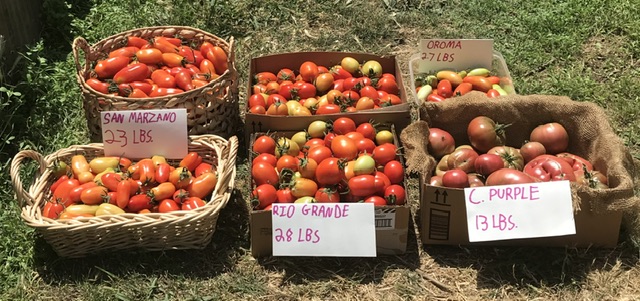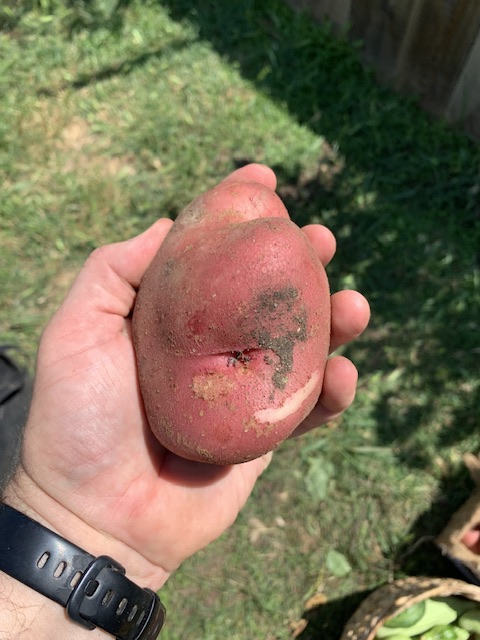The heat has arrived with a vengeance. Everyone knew the freakishly mild temperatures experienced in the Sacramento Valley into the second week of July wouldn’t last and, as expected, the heat dome that has been cooking the American Southwest for weeks finally expanded to encompass California. Daytime highs for the past several days have been over 100°F with some days topping out in the 107° to 108° range.
In spite of the extreme temperatures, the gardens are, so far, holding strong. I credit this to a combination of deep raised beds, a deep mulch layer, and shade cloth which are collectively holding in moisture and keeping roots cool. I gave everything a long deep watering via drip irrigation just prior to the start of the heatwave and I have not yet had to water again. All plants are still looking vibrant and healthy.
Over the last month, our garden kicked heavily into production mode and we’ve been harvesting fresh vegetables daily. So far, we have harvested a little more than 100lbs of produce from our gardens and the season is far from over. Here are the July highlights:
Tomatoes
Overall, we are having a banner tomato year. As I hit the go-button on this article, our total tomato yield for all varieties combined stands at 131 lbs. As planned, most of this yield consists of our three paste tomato varieties, San Marzano, Rio Grande, and Oroma.

While I’m fairly happy with this yield, I would be remiss if I didn’t touch on the bad along with good. Our San Marzano and Oroma varieties were hit fairly hard by the dreaded arch nemesis of sauce tomatoes: Blossom end rot.
Caused by a calcium deficiency within a tomato plant (but not necessarily in the soil), blossom end rot results in a necrotic rot spot at the end of a tomato that typically renders it inedible. I’m estimating we’re losing about a third of our San Marzano and half of our Oromas to end rot. Interestingly, our Rio Grande tomatoes are tremendously resistant to end rot and I’m only encountering the occasional affected fruit. I am planning on addressing the scourge of blossom end rot in future articles as I research into and experiment with various countermeasures.
In other tomato related news, our Cherokee Purple slicing tomatoes have recently been ripening faster that we can eat them (we dehydrate and grind into powder what we can’t eat fresh) and we’ve had a small but steady trickle of black cherry and sun gold cherry tomatoes. The low yield of cherry tomatoes is entirely the result of poor research on my part. I pruned our indeterminate cherry tomatoes down to two stems like I did with our San Marzanos and Cherokee Purples which severely diminished production. Lesson learned.
Finally, it recently dawned on me that the Sacramento Valley won’t be under danger of frost until some time in November and indeterminate tomatoes produce fruit quickly. As such, I started a second round of indeterminate sauce tomatoes that should have a crop ready by September or October as long as I can coddle them through the extreme heat that typically dominates the forecast through August and the into September.

Potatoes
The late arrival of consistent extreme high temps to the Sacramento Valley meant an unusually long potato growing season season this year. Our potato plants made it into early July before the vines began to yellow and die, indicating they had produced all the tubers they were going to.
While most of the varieties we had going did ok in terms of production (32 lbs. total) the Yukon Gold potatoes greatly outshined the other varieties. Two, 2’x2’ planters of Yukon Gold potatoes (four plants per container) yielded 15 lbs. The remaining 21 plants (Sifra, Bellantina, and Red Lasoda varieties) in aggregate accounted for the remaining 17 lbs. of tubers. In the future, more space will be devoted to Yukon Gold.

Cucumbers
Both our Armenian cucumbers and Boston pickling cucumbers are coming to the end of their lifespans having yielded a total of 18 lbs. and 7 lbs. respectively. There are no blossoms left on the Armenian cucumber plants so the fruits that are forming are the last we are going to get. There are blossoms remaining on the Boston pickling cucumber plants, but now that the extreme heat has arrived, the pollen might not be viable. I expect a few more odd cukes to trickle in over the next week or two.

Winter Squash
I suspect this year’s winter squash harvest might be a little underwhelming compared to last year when we harvest more than 200 lbs. Our three golden nugget squash plants gave up the ghost having yielded only ten mature fruits and I’m only finding a handful of fruits mixed into the overgrown tangle that is our Seminole pumpkin bed.

The dark horse of our winter squash harvest this year might be our bush variety butternut squash (butterbush). We have a total of four plants going with a total of a dozen hefty, robust fruits ripening between them.
In all honesty, I don’t mind having a little less winter squash than last year. We were unable to eat all we grew and no one we know wanted any. As a result, a lot of what we produced wound up as chicken food and compost. I don’t mind having a more manageable squash harvest this year.
Peppers
Our Bell peppers are slowly but steadily producing fruits that we’re allowing to fully ripen to a deep red. Currently, there are 20 good fruits ripening with many more healthy blossoms waiting to develop.
We have also begun to harvest jalapeño, Serrano, and Cayenne peppers. Some are being dried and powdered while others will go into salsa when we’re ready to start canning.

